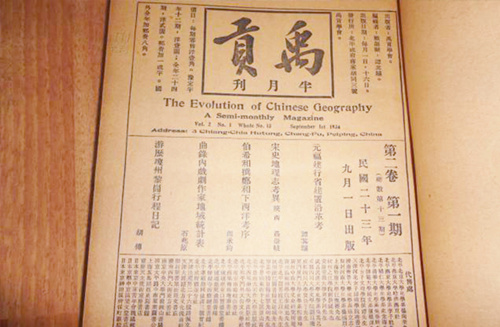
. > WHAT'S NEW > RESEARCH
Scholars of historical geography explore man-land relationship
Author : ZHANG YIXIN Source : Chinese Social Sciences Today 2020-08-10

The Evolution of Chinese Geography (1934–1937), a semimonthly journal, greatly promoted the modernization of Chinese historical geography. Photo: FILE
Historical geography is a discipline that studies the interaction between changes in geographical environments and human activities in specific historical periods. At present, historical geography is seeking further development as a practical discipline in China.
The predecessor of China’s field of historical geography was evolutionary geography, the study of changes in administrative divisions and place names, said Zhang Xiaohong, director of the Center for Historical Geographical Studies at Fudan University. In 1934, Gu Jiegang (1893–1980) and Tan Qixiang (1911–1992) co-founded the Yu Gong Society and the semimonthly journal The Evolution of Chinese Geography, promoting the transformation of traditional evolutionary geography into modern historical geography. In the second half of the 20th century, historical geography gradually matured, forming multiple sub-disciplines such as historical physical geography, historical human geography, borderland history and geography, and the history of cartography. In the 21st century, historical geography has now fully absorbed the research concepts and methods of other disciplines, and the research paradigm has developed from qualitative research to a combination of quantitative and qualitative research, greatly raising the accuracy of research findings.
Wang Shejiao, dean and a professor of the Northwest Institute of Historical Environment and Socio-Economic Development at Shaanxi Normal University, said that the major task of historical geography is to discuss the impact of human activities on different geographical environments and the impact of changes in geographical environments on socio-economic and cultural development by simulating geographical environments in historical periods. At present, the discipline is experiencing very rapid development in China, with new features typical of the era, such as the application of technologies based on historical geographic information systems and model analysis. Focus is shifting from description of the knowledge of historical geography, the simulation of geographic environments during different historical periods and studies on spatial heterogeneity to research into the process and mechanisms of spatial evolution and the simulation of complex man-land systems.
Wang added that some of the fields’ trending research topics respond to the internal demand of disciplinary development, such as construction of historical geographic information systems and the compilation of historical atlases. Other trending topics aim to serve the needs of major national strategies and economic and cultural construction, such as studies on historical geography in regions along the Belt and Road and in borderlands. These above two reasons taken together have generated such focuses as regional construction and the process of regional spatial expansion, land utilization and environmental change, and environmental history.
Tang Xiaofeng, a professor from the Institute of Historical Geography at the College of Urban and Environmental Sciences at Peking University, said that historical geographers pay attention to the value of historical experience and historical heritage, which are important resources in the coordinated development of contemporary economic and cultural causes. Historical geography provides a new view of geography—geography in the context of the man-land relationship. It regards our geographic environments as an accumulative process composed of different historical units. The perspective of the man-land relationship makes historical geography more practical and useful for current issues.
Cheng Yinong, a professor from the School of History and Archives at Yunnan University, said that as a branch of geography, historical geography possesses a practical nature. The historiography of ancient China also adheres to the concept of “study for practical use.” In this context, scholars of historical geography have been deeply influenced by this idea.
Historical geography provides historical and cultural resources and a decision-making basis for contemporary economic and cultural construction through studying geographical environments in certain historical periods. It helps improve our understanding of the man-land relationship and promotes national development. For instance, scholars have found that long-term unplanned agricultural development has further destroyed forest and grassland vegetation, aggravated water and soil loss in the Loess Plateau region, and intensified the sedimentation in the lower reaches of the Yellow River. These findings can provide theoretical support for strategies regarding national governance of the Yellow River and water and soil conservation in the Loess Plateau, Wang explained.
Most researchers in this field have a historiography background, lacking the modes of thinking and the research paradigms of the geography field. As such, historical geographers should consciously strengthen geographical training and actively cooperate with geographers, while tracking changes in historical theories and research methods, Cheng concluded.
Ye Shengtao made Chinese fairy tales from a wilderness
Ye Shengtao (1894–1988) created the first collection of fairy tales in the history of Chinese children’s literature...
-
How northern ethnicities integrated into Chinese nation
2023-09-18
-
Mogao caves
2023-09-12
-
Mogao Grottoes as ‘a place of pilgrimage’
2023-09-12
-
Time-honored architectural traditions in China
2023-08-29
-
Disentangling the civilizational evolution of China
2023-08-28
-
AI ethics in science fiction
2023-08-23













 2011-2013 by www.cssn.cn. All Rights Reserved
2011-2013 by www.cssn.cn. All Rights Reserved